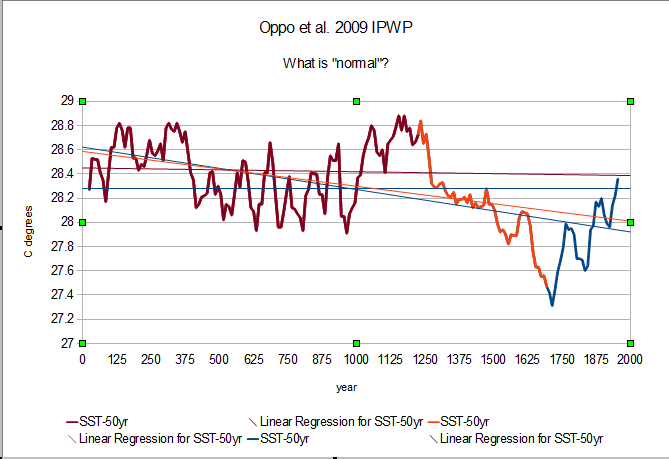In the past with the Drake Passage closed, there would have been two southern hemisphere ocean basins and with the Panama area open, there would have been a more common tropical ocean reducing the basins to possibly two, Atlantic and Pacific. Longer term climate oscillations would be effected by the number of effective basins.
Each basin has equatorial surface currents driven by winds westward then northward when they encounter continental land mass. Since the poles are the ultimate heat sink for the basins, the North Atlantic has the least effective heat sink followed by the North Pacific and thanks to the Drake Passage the Southern Hemisphere oceans have the most effective heat since. Evaporation is the second major heat sink of the oceans so the North Atlantic with higher average surface temperatures produce a larger fraction of latent heat loss that ends as precipitation on land mass followed by the Northern Pacific and the SH oceans.
"Corrientes-oceanicas" by Dr. Michael Pidwirny
The northern portion of the Atlantic basin peaks around 20 C currently.
The northern portion of the Pacific peak around 18C, currently.
The Southern oceans for 30S to 65S peak at around 12.5 C degrees surrently.
If you look at the range of temperatures, the southern 30-65 has close to a 4 C range, Pacific 30-65 about a 9 C range and the northern Atlantic also about a 9 C range.
The tropics, 30S-30N in this case, have a small range, less than 2 C and the current peak temperature is close to 26.5 C degrees which may be a physical limit or close to it.
In some ideal world you could simply use the tropics as a base for the tidal signal, track the lag in each basin then yell EUREKA! Not that easy in this world.
In this chart I have smoothed the three basins using a 27 month cascade and the full series base line for the anomaly. The SH takes a huge dip circa 1900, the Atlantic a few year later and the Pacific has a slightly different dip about 5 years after than. The volcanic forcing estimated by BEST provides a timing back drop.
Here I have lagged the SH by 10.5 years and the Atlantic by 5 years to nearly synchronize the dips. It looks pretty unlikely that the ~1884 volcanic forcing could have caused the dips or the lags from the subsequent volcanoes would coincide with other similar dips that don't appear to exist. There just doesn't appear to be enough data to make much of a case for anything other than there appears to be five 1/2 year lag of the northern Atlantic to the SH and a five year lag of the northern Pacific of the northern Atlantic, and that in a cooling response mode, the SH can cool more easily than the northern Atlantic which can cool easier than the northern Pacific at least under the conditions that existed at the beginning of the 20th century.
The tropics versus the southern oceans 30-65 show part of the complexity. While the Tropics provide the majority of the energy for the thermal tide, the southern ocean sink can dominate heat loss. Since this event happened prior to consistent data collection near the Antarctic, it will be a major challenge figuring out a convincing cause. A small consolation may be that the 1941-1945 appears to be an over shoot of recovery from that event.
This is where I became more interested to tropical ocean paleo reconstructions, in particular, the Oppo et al. 2009 Indo-Pacific Warm Pool. reconstruction
In particular the 1700 to end portion.
So in my opinion, the thermal tide analogy has potential but it is not a slam dunk without some serious work mainly on paleo because there appears to be a 300 plus year recovery of tropical ocean temperatures.










No comments:
Post a Comment